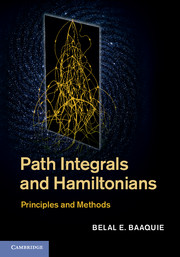Book contents
- Frontmatter
- Dedication
- Contents
- Preface
- Acknowledgements
- 1 Synopsis
- Part one Fundamental principles
- Part two Stochastic processes
- Part three discrete degrees of freedom
- Part four Quadratic path integrals
- Part five Action with acceleration
- Part six Nonlinear path integrals
- 16 The quartic potential: instantons
- 17 Compact degrees of freedom
- 18 Conclusions
- References
- Index
16 - The quartic potential: instantons
from Part six - Nonlinear path integrals
Published online by Cambridge University Press: 05 April 2014
- Frontmatter
- Dedication
- Contents
- Preface
- Acknowledgements
- 1 Synopsis
- Part one Fundamental principles
- Part two Stochastic processes
- Part three discrete degrees of freedom
- Part four Quadratic path integrals
- Part five Action with acceleration
- Part six Nonlinear path integrals
- 16 The quartic potential: instantons
- 17 Compact degrees of freedom
- 18 Conclusions
- References
- Index
Summary
The simple harmonic oscillator is exactly soluble because it has a quadratic potential and yields a linear theory in the sense that the classical equation of motion is linear. Nonlinear path integrals have potentials that typically have a quartic or higher polynomial dependence on the degree of freedom, or the potential can be a transcendental function, such as an exponential. The techniques discussed for quadratic Gaussian path integrals needed to be further developed for nonlinear path integrals. In general, to solve these nonlinear systems, one usually uses either a perturbation expansion or numerical methods.
A perturbation expansion is useful if the theory has a behavior that is smooth about the dominant piece of the action or Hamiltonian; in practice a smooth expansion of the physical quantities yields an analytic series in some expansion parameter, say a coupling constant g, around g = 0.
There are, however, cases of physical interest for which nonperturbative effects change the qualitative behavior of the theory. Two examples where nonperturbative effects dominate are the following:
• Tunneling through a finite barrier. If one perturbs about the lowest lying eigen-states inside a well, one cannot produce the tunneling amplitude.
• The spontaneous breaking or restoration of a symmetry cannot be produced by perturbing about an incorrect ground state.
Tunneling and symmetry breaking are nonperturbative because these effects depend on g as exp{—1/g}, which is nonanalytic about g = 0, and hence cannot be obtained by perturbation theory.
- Type
- Chapter
- Information
- Path Integrals and HamiltoniansPrinciples and Methods, pp. 351 - 384Publisher: Cambridge University PressPrint publication year: 2014



